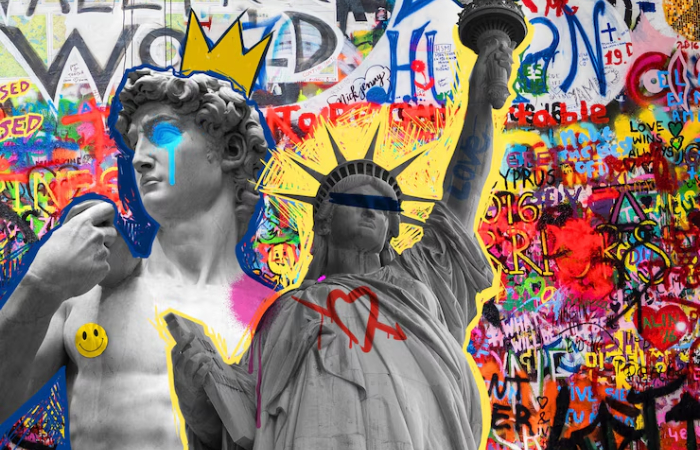Origins of punk art: a visual rebellion
Punk art emerged in the mid-1970s as a raw, unfiltered visual language that echoed the anti-establishment ethos of the punk rock movement. Rooted in DIY culture, it rejected traditional artistic norms, favoring collage, photomontage, and handmade graphics that conveyed messages of dissent and individuality. This visual style was not confined to galleries; it permeated album covers, concert flyers, and zines, becoming an integral part of punk’s cultural expression.
Aesthetic characteristics: rawness and provocation
The aesthetic of punk art is characterized by its rawness, provocation, and anti-commercial stance. Utilizing materials like newspaper clippings, handwritten text, and xeroxed images, artists created works that were intentionally rough and unpolished. This approach mirrored the music’s aggressive sound and the movement’s rejection of mainstream culture.
Influential artists and their contributions
Several artists played pivotal roles in shaping punk art:
- Jamie Reid: Known for his iconic work with the Sex Pistols, Reid’s ransom-note style graphics became synonymous with punk’s visual identity.
- Linder Sterling: Her photomontages, combining images from pornography and domestic magazines, challenged gender norms and consumer culture.
- Raymond Pettibon: His stark black-and-white drawings for bands like Black Flag captured the angst and disillusionment of the era.
- Cynthia Connolly: Documented the Washington D.C. punk scene through photography and design, notably the cover art for Minor Threat’s «Out of Step».
Punk art’s influence on contemporary culture
The impact of punk art extends beyond its origins, influencing various aspects of contemporary culture:
- Graphic design: The movement’s DIY aesthetic has inspired designers to embrace imperfection and authenticity.
- Fashion: Punk’s visual elements have been incorporated into mainstream fashion, challenging traditional norms and promoting individual expression.
- Fine art: Museums and galleries have recognized punk art’s significance, featuring exhibitions that explore its themes and legacy.
Punk art in the digital age
In the digital era, punk art continues to evolve:
- Online platforms: Artists share their work through social media and digital galleries, reaching wider audiences.
- Digital tools: The use of software allows for new forms of expression while maintaining the movement’s core principles.
- Global influence: Punk art’s themes resonate worldwide, inspiring artists across cultures to adopt its rebellious spirit.
Conclusion: the enduring legacy of punk art
Punk art remains a powerful testament to the enduring human desire for self-expression and resistance against conformity. Its raw aesthetics and provocative messages continue to inspire artists and audiences alike, affirming its place as a significant cultural force.
To further explore the world of punk art, consider these selections:
- Punk Rock by John Robb: A comprehensive history of the punk movement, offering insights into its cultural and artistic impact.
- Retro Punk Aesthetic Wall Collage Kit: A DIY decor set that captures the essence of punk visuals, perfect for personalizing your space.
- Stay Punk Poster by dolceQ: An inspirational art piece that embodies the rebellious spirit of punk.
These items provide both educational and aesthetic value, allowing you to immerse yourself in the punk art experience.
